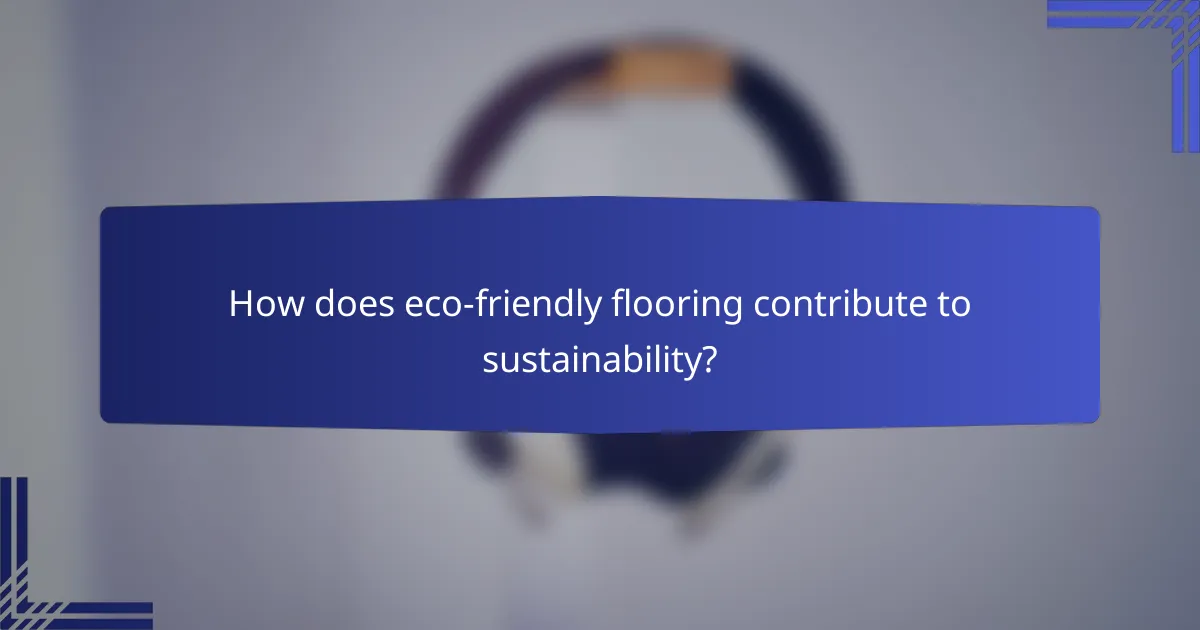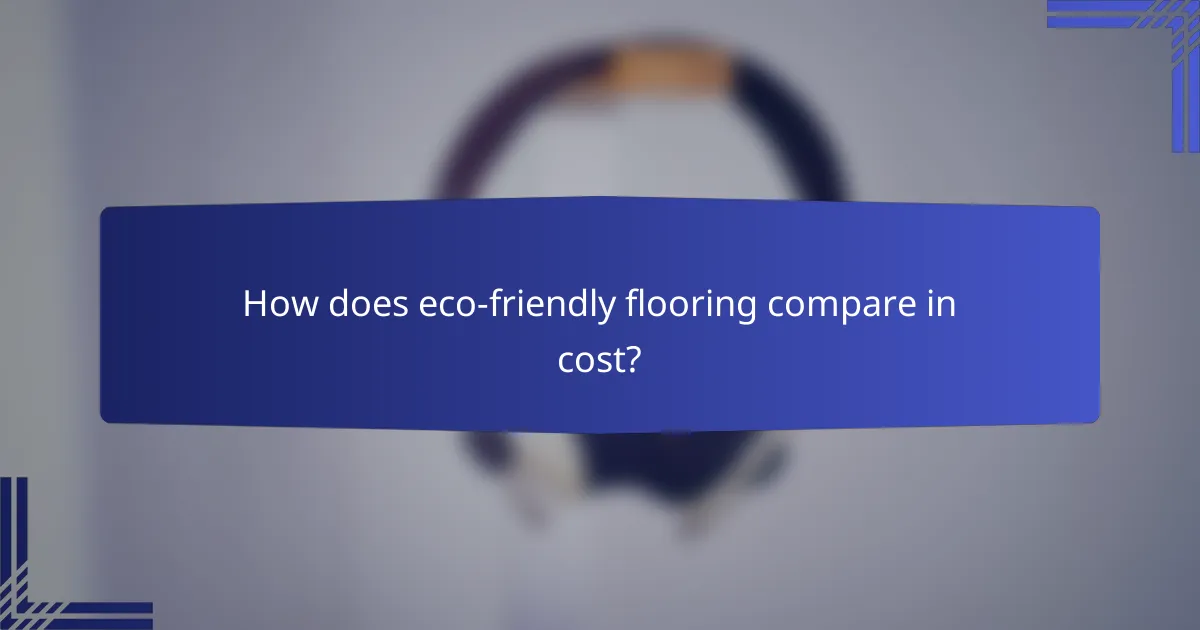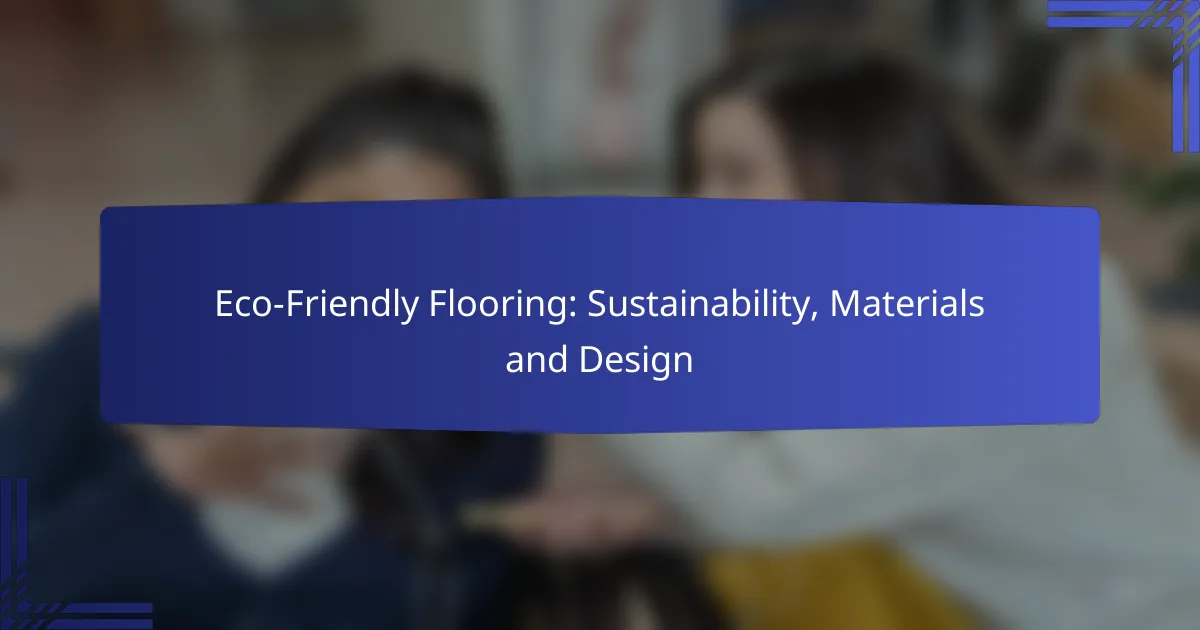Eco-friendly flooring offers a sustainable alternative to traditional materials, utilizing options like bamboo, cork, and reclaimed wood. By choosing these renewable resources, consumers can significantly lower their environmental impact while enjoying durable and stylish designs. When selecting flooring, it’s essential to consider the source, longevity, and maintenance needs to ensure a responsible and lasting choice for both your home and the planet.

What are the best eco-friendly flooring options?
The best eco-friendly flooring options include bamboo, cork, reclaimed wood, linoleum, and rubber. These materials are sustainable, often made from renewable resources, and can significantly reduce your environmental footprint.
Bamboo flooring
Bamboo flooring is made from the fast-growing bamboo plant, which can reach maturity in just a few years. This rapid growth makes it a highly renewable resource, and it is often produced with minimal environmental impact.
When considering bamboo, look for products that are certified by organizations like the Forest Stewardship Council (FSC) to ensure sustainable harvesting practices. Bamboo flooring is durable and can be a stylish addition to various interior designs.
Cork flooring
Cork flooring is harvested from the bark of cork oak trees without harming the tree itself, allowing it to regenerate. This makes cork a renewable and sustainable option for flooring.
Cork is naturally resistant to mold and mildew, making it a healthy choice for indoor environments. It also provides excellent insulation and cushioning underfoot, which can enhance comfort in living spaces.
Reclaimed wood flooring
Reclaimed wood flooring is sourced from old buildings, barns, and other structures, giving new life to wood that would otherwise go to waste. This option not only reduces deforestation but also adds character and history to your home.
When choosing reclaimed wood, verify its source and ensure it has been properly treated for pests and contaminants. This flooring can vary in price depending on rarity and condition, but it often adds significant value to a property.
Linoleum flooring
Linoleum is made from natural materials like linseed oil, cork dust, and wood flour, making it biodegradable and eco-friendly. It is a durable option that can last for decades with proper care.
Linoleum is available in a wide range of colors and patterns, allowing for creative design possibilities. It is also easy to clean and maintain, making it suitable for both residential and commercial spaces.
Rubber flooring
Rubber flooring is made from natural rubber or recycled rubber products, making it a sustainable choice. It is commonly used in gyms and play areas due to its shock-absorbing properties and durability.
When selecting rubber flooring, consider options that are free from harmful chemicals and have low volatile organic compound (VOC) emissions. This flooring is available in various colors and textures, providing versatility for different environments.

How does eco-friendly flooring contribute to sustainability?
Eco-friendly flooring contributes to sustainability by using materials and practices that reduce environmental impact. This type of flooring often involves renewable resources, lower emissions, and waste reduction, making it a responsible choice for both consumers and the planet.
Reduces carbon footprint
Eco-friendly flooring significantly reduces the carbon footprint associated with traditional flooring options. Materials such as bamboo, cork, and reclaimed wood require less energy to produce and transport, leading to lower greenhouse gas emissions. Choosing local suppliers can further minimize transportation emissions.
When selecting flooring, look for certifications like FSC (Forest Stewardship Council) or SFI (Sustainable Forestry Initiative) that indicate responsible sourcing. These certifications ensure that the materials used have a reduced environmental impact.
Promotes renewable resources
Many eco-friendly flooring options are made from renewable resources, which means they can be replenished naturally over time. For instance, bamboo grows rapidly and can be harvested every few years without harming the ecosystem. Cork, harvested from the bark of cork oak trees, can be collected without cutting down the trees, allowing them to continue growing.
When considering flooring materials, prioritize those that are sustainably sourced and have a minimal impact on the environment. This not only supports ecological balance but also encourages the market for renewable materials.
Minimizes waste
Eco-friendly flooring minimizes waste through the use of recycled materials and efficient manufacturing processes. Many products incorporate reclaimed wood or recycled plastics, reducing the need for new raw materials and diverting waste from landfills. This approach not only conserves resources but also decreases pollution associated with production.
To further minimize waste, consider flooring options that are designed for longevity and can be easily repaired or refinished. This extends the life of the flooring and reduces the frequency of replacements, contributing to a more sustainable living environment.

What factors should you consider when choosing eco-friendly flooring?
When selecting eco-friendly flooring, consider the material source, durability, and maintenance requirements. These factors will help ensure that your flooring choice is sustainable, long-lasting, and easy to care for.
Material source
The material source of eco-friendly flooring is crucial as it determines the environmental impact of the product. Look for materials that are renewable, recycled, or sustainably harvested, such as bamboo, cork, or reclaimed wood. Certifications like FSC (Forest Stewardship Council) can help identify responsibly sourced options.
Additionally, consider the production process. Flooring made with low-VOC (volatile organic compounds) adhesives and finishes is preferable, as it contributes to better indoor air quality. Always check for transparency in the supply chain to ensure ethical sourcing practices.
Durability
Durability is a key factor in eco-friendly flooring, as longer-lasting materials reduce the need for replacements and minimize waste. Options like bamboo and cork are known for their resilience, while hardwood can last for decades if properly maintained. Assess the wear layer thickness and warranty offered by the manufacturer to gauge longevity.
Keep in mind that some eco-friendly materials may require specific conditions to maintain their durability. For example, cork can be sensitive to moisture, so it’s essential to consider the environment where the flooring will be installed.
Maintenance requirements
Maintenance requirements can significantly affect the sustainability of your flooring choice. Eco-friendly flooring options often have varying levels of upkeep; for instance, bamboo and cork may need periodic sealing to protect against moisture, while hardwood requires regular refinishing. Understanding these needs can help you choose a flooring type that fits your lifestyle.
To simplify maintenance, consider flooring that is easy to clean and resistant to stains. For example, vinyl flooring made from recycled materials can be a low-maintenance option. Always follow the manufacturer’s care instructions to prolong the life of your eco-friendly flooring.

How does eco-friendly flooring compare in cost?
Eco-friendly flooring typically has a higher initial cost compared to conventional options, but it can offer significant savings over time. The choice of materials, installation methods, and long-term benefits play crucial roles in determining the overall financial impact.
Initial investment
The initial investment for eco-friendly flooring can vary widely depending on the material chosen. Options like bamboo or cork may range from moderate to high prices, often starting around $3 to $10 per square foot. In contrast, reclaimed wood or high-end sustainable tiles can exceed $15 per square foot.
Installation costs can also differ, as some eco-friendly materials require specialized expertise. It’s advisable to factor in both the product and labor costs when budgeting for your flooring project.
Long-term savings
While eco-friendly flooring may require a larger upfront expenditure, it often leads to long-term savings through durability and lower maintenance costs. Many sustainable materials are designed to last longer than traditional options, reducing the need for replacements.
Additionally, eco-friendly flooring can contribute to energy efficiency, especially if it includes insulation properties. This can lead to reduced heating and cooling costs, further enhancing overall savings.
Value retention
Eco-friendly flooring can retain its value well, particularly in markets where sustainability is a priority for buyers. Homes with green features often attract eco-conscious consumers, which can enhance resale potential.
Investing in high-quality, sustainable flooring can not only improve your home’s aesthetic appeal but also increase its market value. Consider the long-term benefits when evaluating the cost of eco-friendly options, as they may yield a better return on investment compared to conventional materials.

What design styles work well with eco-friendly flooring?
Eco-friendly flooring complements various design styles by enhancing sustainability while maintaining aesthetic appeal. Popular styles include modern minimalist, rustic farmhouse, and Scandinavian, each offering unique characteristics that harmonize with eco-conscious materials.
Modern minimalist
The modern minimalist style emphasizes simplicity and functionality, making it an excellent match for eco-friendly flooring. Materials like bamboo or reclaimed wood can provide a clean, uncluttered look while reducing environmental impact.
Consider using light-colored, natural finishes to maintain an airy feel. Avoid overly ornate patterns or textures that may detract from the minimalist ethos.
Rustic farmhouse
Rustic farmhouse design celebrates warmth and charm, often featuring natural materials that align with eco-friendly principles. Flooring options like wide-plank hardwood or cork can enhance the cozy atmosphere while being sustainable.
Incorporate distressed finishes or reclaimed wood to add character. Pair these with earthy tones and vintage furnishings for a cohesive look that feels inviting and environmentally responsible.
Scandinavian
The Scandinavian design style focuses on minimalism, functionality, and natural elements, making it ideal for eco-friendly flooring choices. Light woods, such as ash or birch, can create a bright, open space that reflects the principles of sustainability.
Opt for simple, clean lines and neutral color palettes to enhance the overall aesthetic. Incorporating textiles and greenery can further complement the natural flooring while promoting a harmonious environment.
